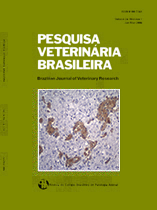 |
|
|
|
Year 2016 - Volume 36, Number 9
|

|
Myocardial velocities obtained by pulsed tissue Doppler in English Cocker Spaniels with dilated cardiomyopathy and congestive heart failure, 36(9):851-856
|
ABSTRACT.- Pereira G.G., Goldfeder G.T., Yamaki F.L., Oliveira V.M.C. & Larsson M.H.M.A. 2016. Myocardial velocities obtained by pulsed tissue Doppler in English Cocker Spaniels with dilated cardiomyopathy and congestive heart failure. Pesquisa Veterinária Brasileira 36(9):851-856. Departamento de Clínica Médica, Faculdade de Medicina Veterinária e Zootecnia, Universidade de São Paulo, Av. Prof. Orlando Marques de Paiva 87, São Paulo, SP 05508-900, Brazil. E-mail: ggpereira2002@yahoo.com.br
Dilated cardiomyopathy (DCM) is characterized by systolic myocardial dysfunction which is identified by low myocardial velocities obtained by pulsed tissue Doppler (PTD). However, increased preload is known to increase myocardial velocities which could overestimate myocardial function and turn dysfunction characterization into a challenge in dogs with DCM and congestive heart failure. To test the hypothesis that increased preload could hamper identification of low myocardial velocities in dogs with DCM and congestive heart failure the present study prospectively evaluated 32 English Cocker Spaniel dogs, being 16 with clinical DCM and 16 healthy for control purpose. The PTD analysis of regional velocities were performed in both longitudinal and radial myocardial displacements and systolic (Sm), early (Em) and late diastolic (Am) velocities were obtained in left ventricular free wall (LVFW) and interventricular septum (IVS). Peak radial subendocardial and subepicardial Sm velocities were lower in DCM group compared to control (0.065±0.018 vs. 0.102±0.020m/s and 0.059±0.014 vs. 0.094±0.025m/s respectively; p<0.001). Peak longitudinal Sm velocities were lower in basal and medial portions of LVFW (0.093±0.034 vs. 0.155±0.034m/s and 0.091±0.033 vs. 0.134±0.037m/s respectively; p<0.001) and IVS (0.063±0.021 vs. 0.136±0.039 and 0.066±0.026 vs. 0.104±0.032m/s respectively; p<0.001). Most of diastolic velocities were not significantly different between groups, although advanced myocardial disease and dysfunction are expected in DCM group. Reduction in systolic basal and medial longitudinal myocardial velocities and in radial myocardial velocities was the most significant PTD findings. Increased preload did not represent a problem to evaluate systolic dysfunction by PTD in English Cocker Spaniels with DCM, but influence of preload on assessment of diastolic velocities should be better elucidated. |
| |
|
|
| |
|
 |